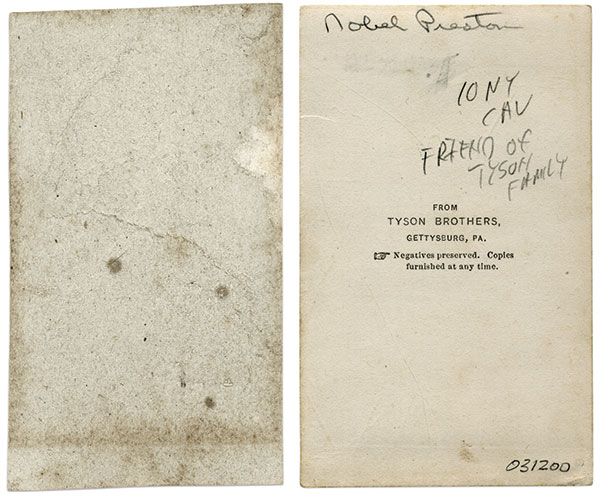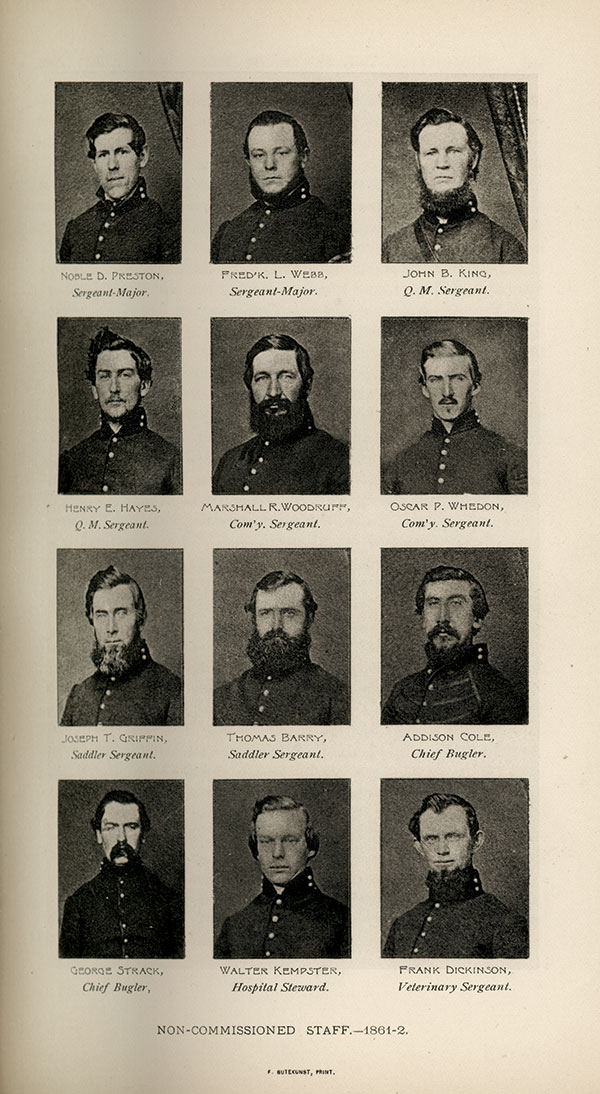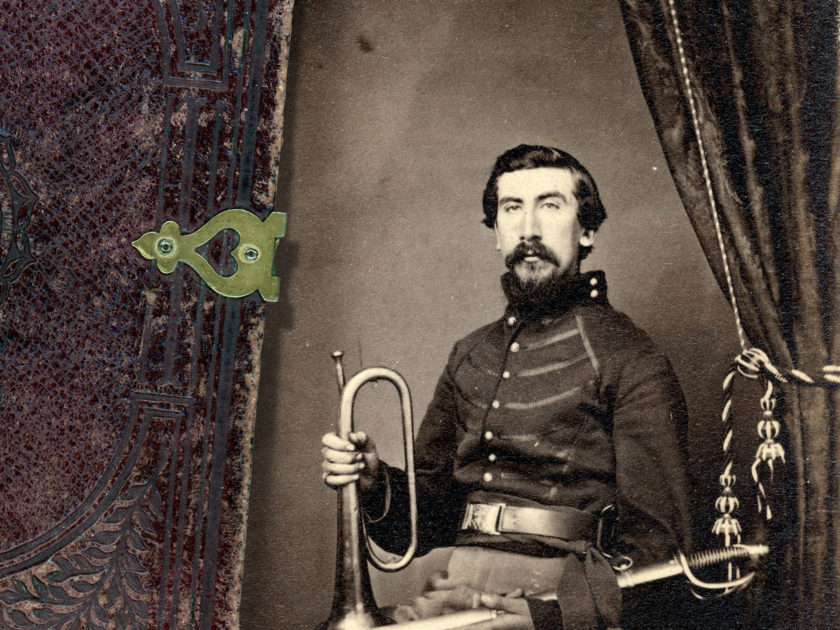By Kyle M. Stetz
On Christmas Day 1861, weary and hungry troopers of the 10th New York Cavalry reported to winter quarters at Gettysburg, Pa. The journey, expected to take eight to 10 hours, had spun out to nearly 24 hours. Their arrival was much later than anticipated by the town’s population. Most had retired for the evening, leaving a few determined citizens to welcome the regiment.
Thus began the connection between the Empire State cavalrymen and the south-central Pennsylvania village—a year-and-a-half before tens of thousands of soldiers descended on the town to fight a momentous battle in the summer of 1863.
How the 10th came to be assigned to Gettysburg had its roots in Washington, D.C., where authorities sought proper sites for military camps. Congressman Edward McPherson, owner of McPherson’s Ridge and the McPherson farm west of Gettysburg, responded. “I represented the accessibility, convenience, and other advantages of Gettysburg. The Hon. Simon Cameron was the Secretary of War, and granted my application,” he wrote years later in a letter to the regiment’s historian, Capt. Noble D. Preston of Company A.
Recruited as the “Porter Guard Cavalry” throughout the late summer and fall of 1861, the regiment completed its muster at Elmira, N.Y., on December 23. Two days later, the Porter Guard arrived in Gettysburg, a town they’d call home for the next 72 days.
Flash forward 146 years. In the spring of 2007, an album containing 12 identified cartes de visite of members of the 10th appeared for sale on eBay. Each image was identified in ink on the bottom of its corresponding album page. The album has red embossed covers, a lyre-shaped closure clasp and a paper label affixed to the fly leaf of the album that reads, “NON-COMMISSIONED STAFF 10TH N.Y. CAVALRY.”
I was unable to acquire the album at the time, but made copies of all the information contained in the auction listing. My attempts to trace it have proved unsuccessful, and the album’s whereabouts remain unknown.

In the summer of 2018, while researching institutions that include materials related to the regiment in their holdings, I discovered that the Clements Library at the University of Michigan has a nearly identical album in its collections. I requested scans of the album, and confirmed that the Clements Library version contained portraits of the same 12 troopers in the eBay album. Only one variation existed: The carte of Commissary Sgt. Oscar P. Whedon depicted him seated in the eBay album, but full-standing in the Clements Library album.
I concocted a wishful theory: If two virtually identical albums existed, possibly others were still out there.
In January of 2020, theory became reality when a collector friend called me with the news that he was parting with an album full of cartes of soldiers from the 10th New York Cavalry. As he began to read the names to me, I realized in an instant that it represented a third version of the album. I was fortunate enough to acquire it.
A study of the three albums reveals marked similarities. The album covers and clasps are identical and nine of the 12 cartes are exactly the same. Some variations exist, as shown in this table. The most notable difference is that my version does not include an image of Veterinary Sgt. James F. Dickinson. A carte of an unidentified soldier has been inserted in his place.
Why and how these images are grouped together
The paper label affixed to two of the albums makes it clear that these men composed the non-commissioned staff. Upon its arrival in Gettysburg in 1861, the regiment consisted of two battalions, as the third was not recruited until the fall of 1862.
A battalion consisted of six non-commissioned staff: sergeant major, quartermaster sergeant, commissary sergeant, saddler sergeant, veterinary sergeant and hospital steward. The two battalions of the 10th had a full compliment of 12. But only 10 of the 12 are represented. Two missing troopers, Hospital Steward Bonville Fuller and Veterinary Sergeant Alvain Butler, served in the second battalion. Possible explanations for their absence might be that the men did not wish to participate in the photography session, or that space limitations within the album prevented their inclusion.

The chief bugler of each battalion, Addison Cole and George Strack, appear in all three albums. Though not officially part of the staff, they did hold battalion-level ranks.
It is not known exactly how these albums were assembled. My favorite theory holds that the soldiers were in it together. Each man sat for his carte de visite, in two different poses, for a total of a dozen prints, kept one for himself and traded the remaining 11 with the others. At least three of the men purchased the same album to hold their set of a dozen cartes, perhaps purchasing them at the same time. It is possible that all the men purchased albums. If they did, nine more duplicate albums may have survived, but not yet surfaced.

Photographed in Gettysburg by the Tyson Brothers
None of the images in my album have back marks, and no reference to photographer or photographers appears in descriptions of the other albums.
One possibility is that they posed for their portraits in Elmira, N.Y., as they waited to be mustered into federal service before leaving for Gettysburg. In fact, a number of the soldiers in the 10th did so. However, a comparison of surviving images by Elmira photographers reveals entirely different background elements.
Another possibility is they posed after leaving Gettysburg. The regiment’s next three assignments were in Maryland: Perryville, Havre de Grace and Baltimore. An examination of backdrops of images of members of the 10th taken in Baltimore does not mesh with the imagery in my non-commissioned staff officer album.
A concurrent service timeline of the 12 individuals indicates the portraits had to have been made between Dec. 28, 1861, when the last trooper joined the staff of non-commissioned officers, and April 21, 1862, when Hospital Steward Walter Kempster received his discharge. Their stay in Gettysburg fits squarely within this timeframe.

The key, in part, to identifying the photographer is a carte in the Rick Carlile Collection. It is a full-standing image of future regimental historian Preston, pictured as a sergeant major. He held this rank during the period the 10th quartered at Gettysburg. Carlile’s carte includes the backmark “Tyson Brothers, Gettysburg, Pa.”
The background of the Preston portrait features an enormous fluted column with a rounded base and a waist-high pedestal with inset rectangular molding; a dark-colored, patterned curtain which is pulled back and held in place with a decorative rope and two, three-tiered tassels between which is a decorative ball; and an ingrain carpet floor covering with a distinctive pattern of interlocking geometric shapes.
These elements are also found in the image of Commissary Sgt. Oscar P. Whedon in my album. Additional research has surfaced other Tyson Brothers’ images with the identical studio setting.
But, what about the remaining cartes in the album? They lack the signature column and feature a different ingrain carpet floor covering.

One of these portraits, the 2nd Battalion’s Chief Bugler George Strack, provides a helpful clue. The curtain and decorative rope perfectly match those visible in the images of Preston and Whedon. However, Strack stands upon a decidedly different carpet. Upon close examination, the rear corner of the carpet Strack stands upon is clearly not tacked into place along the rear wall. Following the discovery of this detail, I studied high-resolution scans of each image in the album. I also surveyed images in another 10th New York Cavalry album in my collection compiled during the war by Pvt. John Vail of Company B. The Vail album includes five images (also lacking back marks) with the Tyson Brothers’ column, curtain and rope, and the carpeting seen in the Whedon and Preston images.
This survey revealed two important features. First, the image of Whedon shows the geometric-patterned carpet bunching between his right foot and the column. Second, the physical distance between the back edge of the carpeting and rear wall noticeably changes between the images. While seemingly insignificant details, it reveals that the Tyson Brothers utilized two carpet floor coverings in their images. These carpets, like the column, could be moved in and out of place to suit the taste of the sitter or photographer.
To date, I have not been able to find another Tyson Brothers’ photograph that features the carpet in the Strack portrait, and, as it turns out, four other cartes in the album.
Another background element of note is the curtain held in place with the decorative rope, three-tiered tassels and decorative ball separating the tassels. It appears in each of the cartes in the album, and matches the one in Carlile’s image of Preston with a Tyson Brothers’ back mark.
When examining the curtain in detail, a discernible woven pattern is visible, and depending on how the curtain was tied in place, more or less of the pattern can be seen.
One background element, a small table with a distinctive woven tablecloth with a pattern of birds, appears in only a single portrait in the album—Commissary Sgt. Woodruff. The tablecloth appears in two other cartes of members of the 10th in my collection, though both are without back marks, but both show the identical curtain, decorative rope, and tassels. Locating an image with a Tyson Brothers imprint, depicting the woven tablecloth with a pattern of birds, seemed a daunting task. The “Hero of Gettysburg,” John Burns, ultimately came to my rescue. Of the many portraits taken of him following the battle, one with a Tyson Brothers imprint includes the distinctive tablecloth with the bird pattern.

It should be noted that the Tysons, Charles J. and Isaac G., were not the only photographers in Gettysburg at this time. John S. Speights also operated a studio. None of the background elements in images credited to him appear in the albums.
Why no back marks?
None of the cartes in my album have back marks, which is unusual for the Tyson Brothers. A comparative study to the Vail album offers a possible explanation. The Tyson Brothers images in the Vail album have thicker than average card mounts. My non-commissioned staff officer’s album images are all pasted on extremely thin mounts. The back of one of the mounts is shown here. Of note is the coarse surface, similar to a nap in fabric and quite the opposite of the normally smooth finish. It appears as though the Tyson Brothers cleaved the mounts in half to create two thin mounts.

If true, this begs a new question. Why did the Tyson Brothers do it? The answer may be that they needed to solve a supply and demand problem. Gettysburg had a population of approximately 2,400 residents when the 10th showed up on Dec. 25, 1861. Overnight, the population in town increased by 33 percent.
It is reasonable to assume that the newcomers, like thousands of other freshly minted soldiers, were eager to have their portraits taken. The sudden surge on demand put pressure on the stock of the Tyson Brothers’ inventory of supplies, including mounts. If my theory holds true that all 12 men posed for two slightly different portraits taken of them, and ended up with a personal copy of the album, that would total 144 images alone. On the extreme end, if all 800 troopers were photographed and each came away with a dozen cartes, 9,600 mounts would be required. Though highly unlikely that this came to pass, the scenario underscores how stocked supplies could be quickly diminished.
If in fact the Tyson Brothers ran out of mounts, it is reasonable to think they began cleaving the mounts in stock to double the inventory. If the Tyson Brothers also supplied the albums and understood from the beginning that the mounts would lie hidden beneath album pages, they may have cleaved the mounts as a frugal practice.
Conclusions
As image collectors, we regard background elements as important aids in our research and identification of images. At times, these studio furnishings are easily identifiable and unique to certain artists, as in the enormous column used by the Tyson Brothers. Other, more subtle clues are nearly concealed and can easily go unnoticed—the bunching of a carpet, the woven designs in a curtain or table covering, and the curling of an edge of carpeting. In this case, careful observation and comparison to other known portraits and documentary evidence confirms that the Tyson Brothers took the images in the 10th New York Cavalry non-commissioned staff album in Gettysburg during the winter of 1861-1862.
Two theories remain unsubstantiated. Did each soldier pictured in the album each leave the Tyson Brothers’ studio with a personal copy in tow? Were the Tyson Brothers running low on their card-mount stock due to an increase in business from the troopers? While these two questions and theories may never be answered, they are interesting to ponder.
The bonds of friendship among the troopers of the 10th and the residents of Gettysburg were strong. The town’s populace warmly welcomed their new temporary residents. About half the time of the regiment’s stay in Gettysburg, the men boarded in homes, warehouses and even the newly-constructed Adams County Courthouse, before constructing barracks east of town. The New Yorkers could little have imagined when they left Gettysburg on March 7, 1862, that they would return 16 months later to fight in the momentous battle that forever marked the town.

In his history of the regiment, Preston recalled his homecoming to Gettysburg on July 4: “A party of refugees were,” he recalled, “returning to their homes in the village, from whom it was learned that the Confederate army had fallen back, leaving the village in possession of the Union forces. Among the refugees was Charles J. Tyson, the photographer, well known to many of the men of the 10th. On reaching the village it was found that the Regiment had just passed through, going on the Chambersburg road. Lieutenant Preston accompanied Mr. Tyson to his residence and afterward visited the photograph gallery with him. Underneath one of the windows of the gallery a shell, which must have been fired from a Confederate battery northwest of the town, was partly imbedded in the brick wall. Other familiar scenes and friends were visited, and many of the members of the Regiment had embraced the opportunity for doing the same.”
Preston’s regimental history is profusely illustrated. On page 16 is a collage of the non-commissioned staff. There is no doubt that the 12 images that appear on this page are cropped versions of the same images in the three surviving albums. The collage appears adjacent to the section that describes the regiment’s first winter in Gettysburg.
Following the 50th Anniversary of the Battle of Gettysburg in 1913, attended by many veterans of the 10th, the regiment printed its annual post-reunion booklet. Typically these booklets were paper-covered in format, but for the golden anniversary of Gettysburg, its members produced a hardbound edition. Many veterans submitted contemporary photos of themselves, and wrote entries describing wartime incidents and reflections on the anniversary. Several recalled that first winter of the war in Gettysburg with fondness and affection.
Frank B. Wood, who had served as a private in Company E, stated, “WE—please put that in capitals—were the first organized troops to enter Gettysburg, Christmas night, 1861; the first cavalry regiment to engage the confederates on the right flank, July 2, 1863, (and but a short distance from our regimental drill grounds of eighteen months before) among the first troops to pass through the town in pursuit of the enemy. The first Union soldier buried in the village cemetery, ‘Evergreen’—John W. Congdon—was from company A of our regiment. Now, who says WE didn’t put down the rebellion?”
The members of the 10th were proud of their Gettysburg connection. Photographs in the non-commissioned staff album document the regiment’s time in a town destined for history. I like to imagine the scene on one of those cold winter days, when a dozen soldiers walked into the Tyson Brothers’ studio and requested portraits of themselves, and maybe a red-covered carte de visite album clutched in each of their hands as they scurried back to their barracks.
Kyle M. Stetz was born and raised in Western New York State and now resides in Central Virginia. He lives there with his wife and two young sons. His collection focuses on his ancestor’s regiment the 10th New York Cavalry, and anything related to soldiers from his native Cattaraugus County, N.Y.
SPREAD THE WORD: We encourage you to share this story on social media and elsewhere to educate and raise awareness. If you wish to use any image on this page for another purpose, please request permission.
LEARN MORE about Military Images, America’s only magazine dedicated to showcasing, interpreting and preserving Civil War portrait photography.
VISIT OUR STORE to subscribe, renew a subscription, and more.

